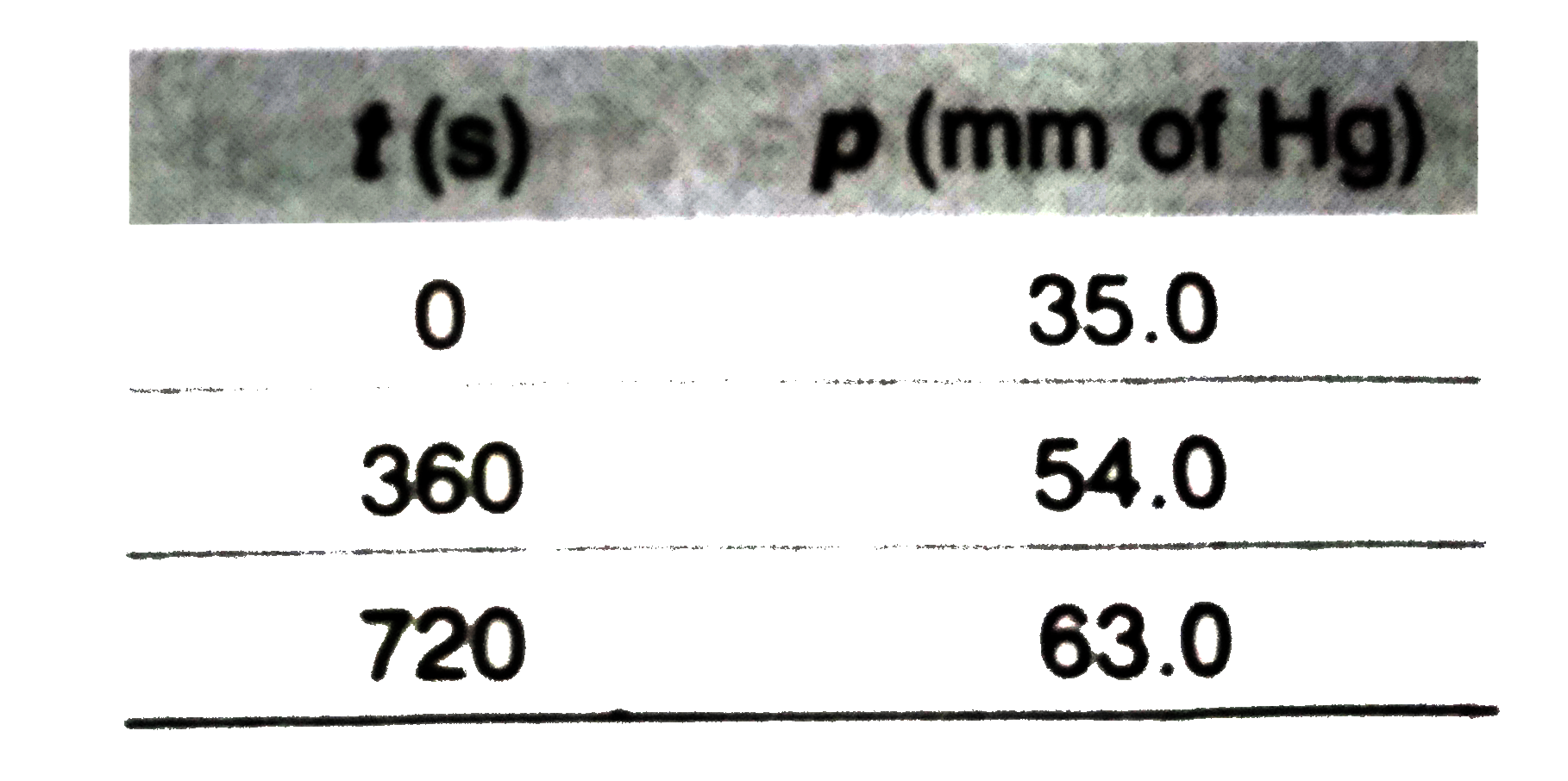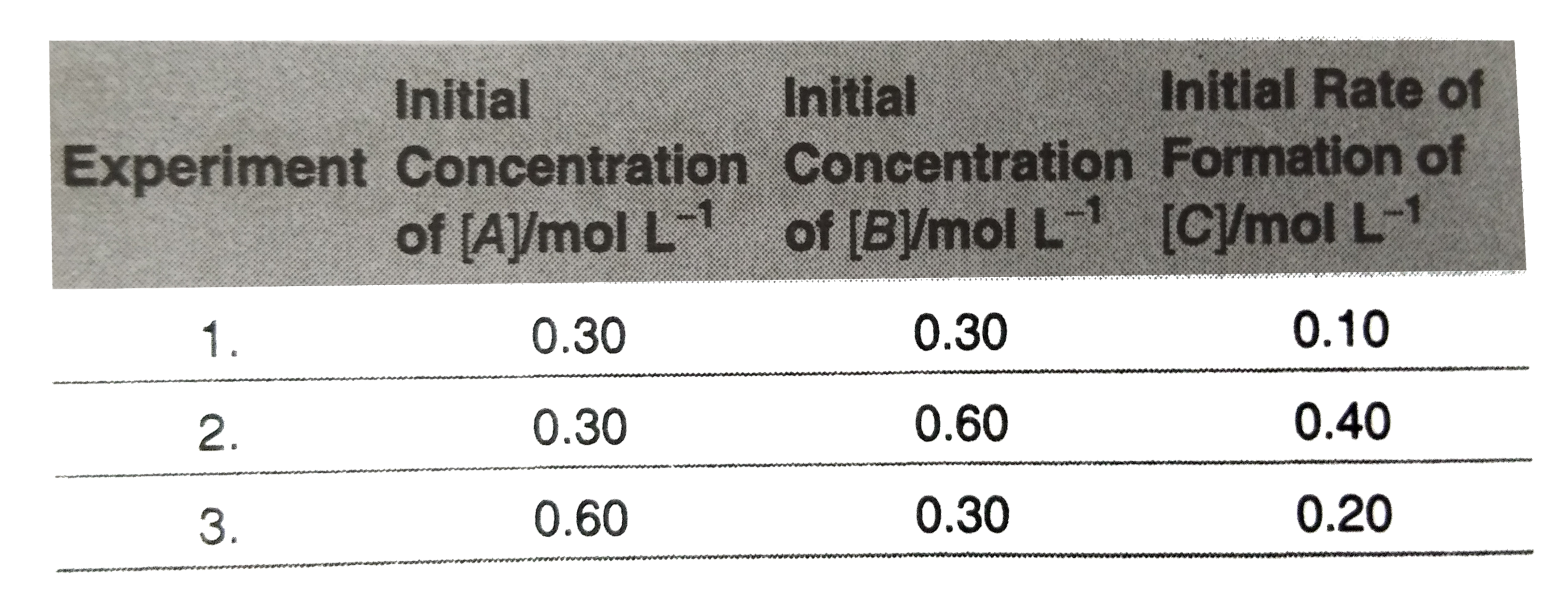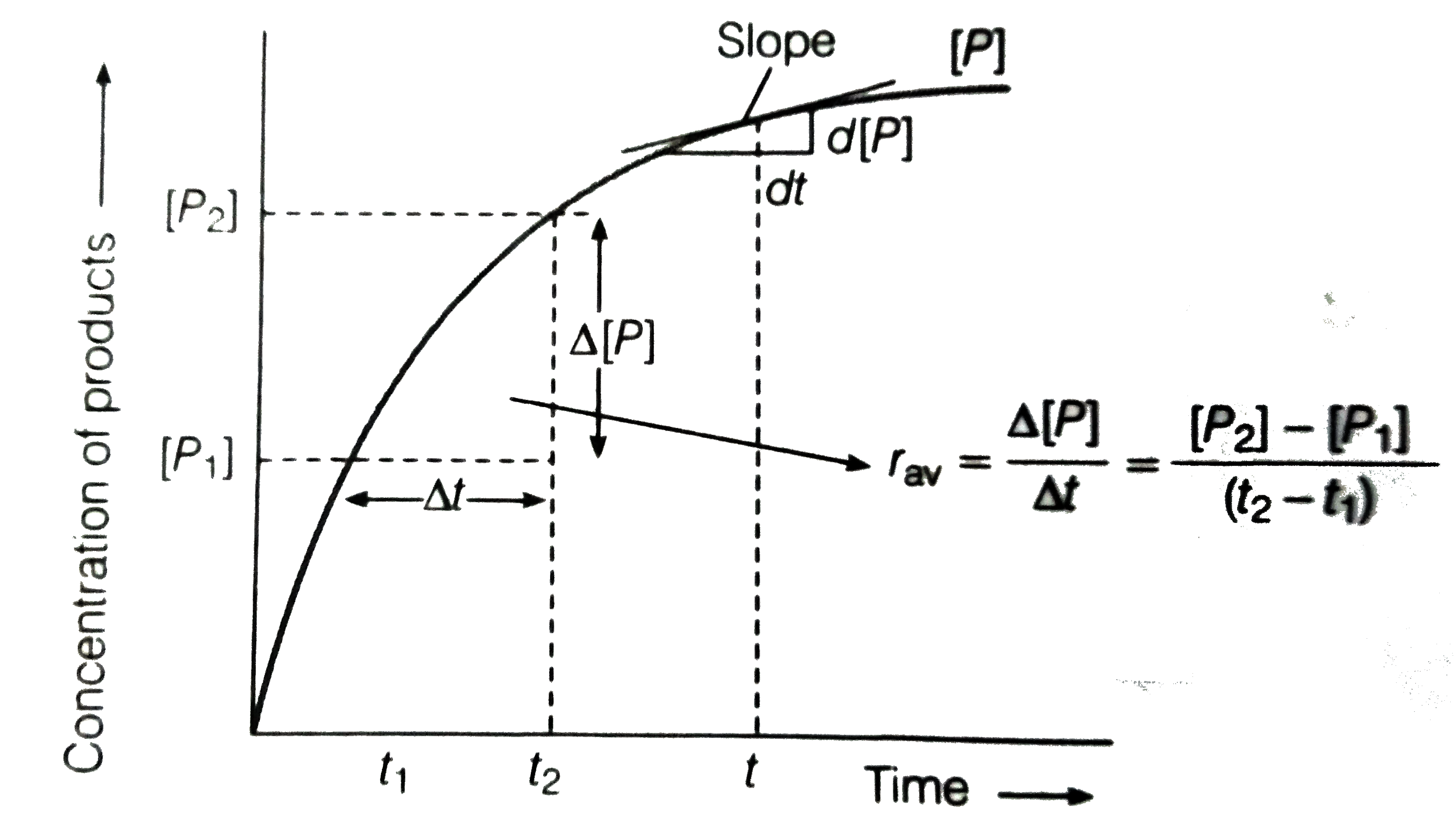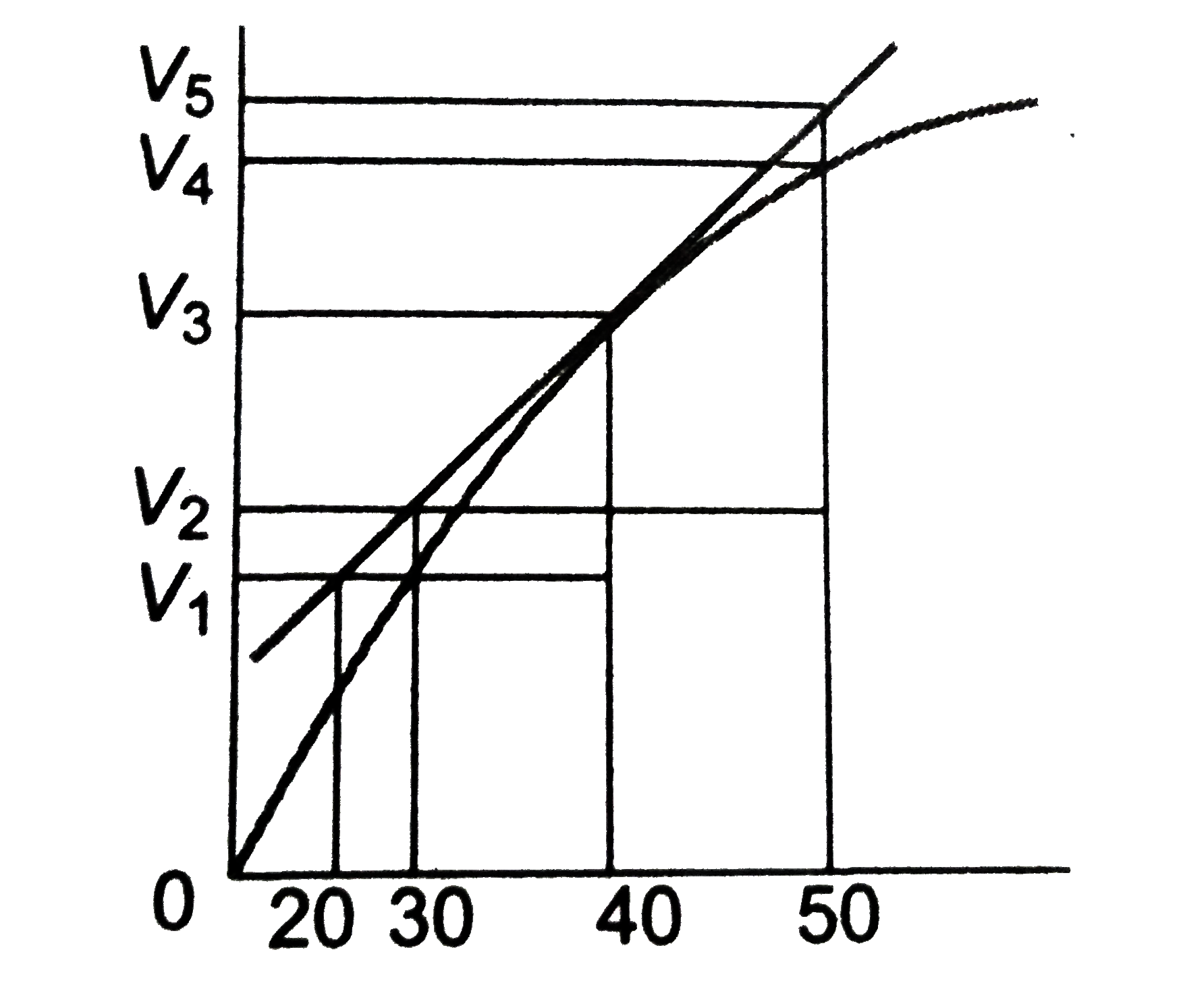Complete Solutions to Exercise 2 of chapter CHEMICAL KINETICS of Class 12 book with complete answers and questions
| Class 12 | CHEMISTRY |
| Chapter | CHEMICAL KINETICS |
| MHTCET PREP GUIDE | Exercise 2 |
| Number Of Questions | 84 |
| Academic Year | 2023-24 |
The activation energy for the reaction `:` ltbr. `2Hl(g) rarr H_(2)(g)+I_(2)(g)`
is `209.5 kJ mol^(-1)` at `581K`. Calculate the fraction of molecules of reactants having energy equal to or greater than activation energy ?
View SolutionThe chemical reaction `2O_(3)rarr3O_(2)` proceeds as follows :
`O_(3)rarrO_(2)O" "` (fast)
`O+O_(3)rarr2O_(2)" "` (slow)
The rate law expression should be :
View SolutionThe rate constant of a reaction increases by 5% when its temperature is raised from `27^@c` to `28^@c.` The activation energy of the reaction is
View SolutionThe time required for 10% completion of a first order reaction at 298 K is equal to that required for its 25% completion at 308 k. If the value of A is `4xx10^(10)s^(-1).`
Calculate the rate constant, k at 318 k.
`2.89xx10^(-2)s^(-1)`
`3.26xx10^(-2) s^(-1)`
`1.03xx10^(-2)s^(-1)`
`0.03xx10^(-2)s^(-1)`
View SolutionThe following data were obtained during the first order thermal decomposition of `SO_(2)CI_(2)` at a constant volume.
`SO_(2)CI_(2)(g)rarrSO_(2)(g)+CI_(2)(g)`

View SolutionWhen initial concentration of a reactant is doubled in a reaction, its half-life period is not affected. The order of the reaction is
View SolutionFor the decomposition of azoisopropane to hexane and nitrogen at 543 K, the following data are obtained.

View Solution1 g of `""_79AU^(198(t_(1//2)=65 h)` gives stable mercury by `beta-emission.` What amount of mercury will left after 260 h?
View SolutionAn endothermic reaction, `Ararr B` have an activation energy `15 kcal//mol` and the heat of the reaction is `5 kcal//mol`. The activation energy of the reaction, `Brarr A` is:
View SolutionThe rate of a reaction quadruples when the temperature changes from `293K` to `313K`. Calculate the energy of activation of the reaction assuming that it does not change with temperature.
View SolutionThe rate law for the reaction
`RCl + NaOH(aq) rarr ROH + NaCl` is given by
Rate `= k[RCl]`. The rate of the reaction will be
View SolutionThe decomposition of `A` into product has value of `k` as `4.5xx10^(3)s^(-1)` at `10^(@)C` and energy of activation of `60kJmol^(-1)`. At what temperature would `k` be `1.5xx10^(4)s^(-1)?`
View SolutionThe rate constant `(K')` of one reaction is double of the rate constant (K") of another reaction. Then the relationship between the corresponding activation energies of the two reactions `(E_(a)^(') "and" E_(a)^(''))` will be
View SolutionThe rate constant of the chemical reaction doubled for an increase of 10 k in absolute temperature from 295 k. Calculate the (activation energy),`E_(a).`
View SolutionPowdered magnesium element catches fire more repidly than magnesium wire of the same mass because
View SolutionCompounds A and B react according to the following chemical equation,
`A(g)+2B(g)rarr2C(g)`
Concentration of either A or B were changed keeping the concentrations of one of the reactants as constant and rates were measured as a function of initial concentration. ltbgt Following results were obtained . Choose the correct option for the rate equations for this reaction.

View SolutionFor the reaction `2H_(2)+O_(2)rarr 2H_(2)O`, the rate law expression is , `r = k[H_(2)]^(n)`. When the concentration of `H_(2)` is doubled, the rate of reaction found to be quadrupled. The value of n is
View Solutionconsider the following reaction,
`N_(2)(g)+3H_(2)(g)hArr2NH_(3)(g)`
The rate of change of concentration for nitrogen is `-0.3xx10^(-4)Ms^(-1).` The rate of change of concentration of ammonia is
View SolutionFor a reaction `Rto P`, the concentration of a reactant changes from 0.03 M to 0.02M in 25 minutes. Calculate the average rate of the reaction using the units of seconds.
View SolutionConsider the following reaction,
`2P_(2)O_(5)rarr4PO_(2)(g)+O_(2)(g)`
If the concentration of PO_(2) increases by `5.2xx10^(-3)M` in 100 s, the rate of a reaction is
View SolutionFor the reaction, `A+Brarr"product"`
If concentration of A is doubled, rate increases 4 times. If concentrations of A and B both are doubled, rate increases 8 times . The differential rate equation of the reaction will be
View SolutionThe rate constant for the first order decomposition of ethylene oxide into `CH_(4) and CO,`
View Solution
On the basis of the curve shown above, identify the correct statement(s).
View SolutionConsider the following reaction,
`N_(2)(g)+3H_(2)(g)hArr 2NH_(3)(g)+22kcal" mol"^(-1)`
The activation energy for the forward reaction is 50 kcal. What is the activation energy for the backward reaction?
View SolutionConsider the following reaction,
`2A + B + C rarr` Products
How will the rate of reaction changes when the concentration of A is doubled and that of B is triplet while C is taken in excess ?
View SolutionWhich of the following expression is correct for the rate of reaction given below ?
`5Br^(-)(aq) + BrO_(3)^(-)(aq) + 6H^(+) (aq) to 3Br_(2) (aq) + 3H_(2) O(l)` .
View SolutionThe reaction `Ararr B` follows first order kinetics. The time taken for `0.8 mol` of `A` to produce `0.6 mol` of `B` is `1 hr`. What is the time taken for the conversion of `9.0 mol` of `A` to Product `0.675 mol` of `B` ?
View SolutionThe rate of formation of `SO_(3)` in the following reaction is `100 g " min"^(-1).2SO_(2)+O_(2)rarr2SO_(3)`
The rate of disappearance of `O_(2)` is
View SolutionConsider the following reaction,
`2N_(2)O_(5)rarr4NO_(2)+O_(2),(d[NO_(2)] )/(dt)=k_(2)[N_(2)O_(5)]`,
`(d[O_(2)])/(dt)=k_(3)[N_(2)O_(5)]" and "(d)/(dt)[N_(2)O_(5)]=k_(1)`
The relation between `k_(1), k_(2)` and `k_(3)` is
View SolutionFor a hypothetical reaction, `ArarrP`
the rate constant is 0.12 `s^(-1).` which of the following relation is correct, if `[R]_(0)` is the initial concentration?
View SolutionThe initial concentration of `N_(2)O_(5)` in the following first order reaction:
`N_(2)O_(5)(g) rarr 2NO_(2)(g)+(1)/(2)O_(2)(g)`
was `1.24 xx 10^(-2) mol L^(-1)` at `318 K`. The concentration of `N_(2)O_(5)` after `60 min` was `0.20 xx 10^(-2) mol L^(-1)`. Calculate the rate constant of the reaction at `318 K`.
View SolutionA following mechanism has been proposed for a reaction
`2A +B rarr D rarr E`
`A+ B rarrC+D `(slow)
`A+C rarr E` (fast)
The rate law expression for the reaction by RDS methd is:
View SolutionThe half-time of the following first order decomposition of nitramide is 2.1 h at `15^(@)C`:
`NH_(2)NO_(2)(aq)rarrN_(2)O(g)+H_(2)O(l)`
If 6.2 g of nitramide is allowed to decompose then time taken for it to decompose 99%, will be
View SolutionConisder a reaction `aG+bH rarr` Products. When concentration of both the reactants `G` and `H` is doubled, the rate increases eight times. However, when the concentration of `G` is doubled, keeping the concentration of `H` fixed, the rate is doubled. The overall order of reaction is
View SolutionFind out two-third `(2//3)` life of a first order reaction in which `k=5.48 xx 10^(-14)s^(-1)`
View SolutionRate constant `k = 1.2 xx 10^(3) mol^(-1) L s^(-1)` and `E_(a) = 2.0 xx 10^(2) kJ mol^(-1)`. When `T rarr oo`:
View SolutionA given sample of milk turns sour at room temperature `(27^(@)C)` in five hours. In a refrigerator at `-3^(@)C`, it can be stored 10 times longer. The energy of acrivation for the souring of milk is
View SolutionThe rate law for a reaction between the substances A and B is given by rate `= K[A]^(n) [B]^(m)`. On doubling the concentration of A and having the concentration of B, the ratio of the new rate to the earlier rate of the reactio will be:
View SolutionThe time required for 100% completion of a zero order reaction is
View SolutionFor a reaction `2Ararr3B,` if the rate of formation of B is `x"mol"//L,` the rate of consumption of A is
View Solution……..A….. Is the expression in which reaction rate is given in term of molar concentration of reactants with each term raised to some power, which may or may not be same as the stoichiometric coefficient of the reacting species in a balanced chemical equation. Here, A is
View SolutionIn the graph,

slope will be
View SolutionConsider some facts about decomposition of `H_(2)O_(2).`
It is catalysed by iodide ion in acidic medium.
It is second order reaction with respect to both `H_(2)O_(2).andI^(-1).`
Rate equation of this particular reaction will be
`Rate=(-d[H_(2)O_(2)]^(2))/(dt)=k[H_(2)O_(2)]^(2)[I^-]`
It completes in two steps and both steps are unimolecular elementary reactions.
Which of the above written facts are correct, regarding decomposition of `H_(2)O_(2)?` Choose the correct option.
View SolutionIf rate constant is numerically the same for three reaction of first, second and third order respectively, then which of the following is correct?
View SolutionFor the reaction,

Half-life does not depend on the concentration of the reactant. After 10 min, volume of `N_(2)` gas is 20L and afer the completion of reaction, it is 100 L Hence, rate constant is
View SolutionThe rate constant of a reaction is given as
`k=2.1xx10^(10)e^(-2700//RT)`
It means that
`"log "k " vs "1//T` will be a straight line with intercept on `"log "k" axis"=log2.1xx10^(10).`
Number of effective collisions of temperature are `2.1xx10^(10)cm^(-3)s^(-1).`
Half-life of a reaction increases of temperature.
`"log"k" vs "1//T` will be a straight line with `slope=-(2700)/(2.303R).`
Which of the above statements are true? Choose the correct option.
View SolutionA graph of volume of hydrogen released vs time for the reaction between zinc and dil. HCI is given in figure. On the basis of this mark the correct option

View SolutionOn mixing 1 `dm^(3)` of 3M ethanol with 1 `dm^(3)` of 2 M ethanoic acid, an ester is formed.
`C_(2)H_(5)OH+CH_(3)COOHrarrCH_(3)COOC_(2)H_(5)+H_(2)O`
If each solution is diluted with an equal volume of water , the decrease in the initial rate would be
View SolutionIn a reversible reaction `2NO_(2)underset(k_(2))overset(k_(1))iffN_(2)O_(4)`, the rate of disappearance of `NO_(2)` is equal to
View SolutionThe conversion of molecules `X` to `Y` follows second order kinetics. If the concenration of `X` is increased to three times, how will it affect the rate of formation of `Y` ?
View SolutionIn the sequence of reaction,
`L overset(k_(1))rarr M overset(k_(2))rarr N overset(k_(3))rarrO`
`k_(3) gt k_(2) gt k_(1)`
The rate determining step of the reaction is :
View SolutionHalf-life of a reaction is found to be inversely proportional to the cube of its initial concentration. The order of reaction is
View SolutionFor an exothermic chemical process occurring in two as
(i) `A + B rarr X` (slow)
(ii) `X rarr AB` (fast)
The process of the reaction can be best described by
View SolutionA reactant `(A)` forms two products
`A overset (k_(1))rarr B`, Activation energy `E_(a1)`
`A overset (k_(2))rarr C`, Activation energy `E_(a2)`
If `E_(a_(2)) = 2E_(a_(1))` then `k_(1)` and `k_(2)` are related as
View SolutionIn a first order reaction, `ArarrP,` the ratio of `a//(a-x)` was found to be 8 after 60 m in. If the concentration is 0.1 M then the rate of reaction is
View SolutionThe rate of a chemical reaction becomes double for every `10^(@)` rise in temperature. If the tempeature is raised by `50^(@)`C, the rate of reaction increases by about:
View SolutionFor a reaction `1//2A to 2B`, rate of disappearance of A is related to the rate of appearance of B by the expression:
View SolutionThe rate of a reaction doubles when its temperature changes form `300 K` to `310 K`. Activation energy of such a reaction will be:
`(R = 8.314 JK^(-1) mol^(-1) and log 2 = 0.301)`
View SolutionA plot of `"Ink "v//s " 1/T"` for a reaction gives the slope `-1xx10^(4)k.` The energy of activation for the reaction is `(Given,R=8.314k^(-1)" mol"^(-1))`
View SolutionIn a zero-order reaction for every `10^(@)` rise of temperature, the rate is doubled. If the temperature is increased from `10^(@)C` to `100^(@)C`, the rate of the reaction will become
View SolutionDuring the kinetic study of the reaction `2A+BrarrC+D,` following results were obtained

Based on the above data which one of the following is correct?
View SolutionThe inversion of cane sugar is first order in [sugar] and proceeds with half-life of 600 min at pH=4 for a given concentration of sugar. However , if pH=5, the half-life changes to 60 min. The rate law expression for the sugar inversion can be written as
View SolutionThe initial rates of reaction `3 A+ 2B +C rarr` products at different initial concentration are given below
`{:("Initial rate, MS"^(-1),|A_(0)|M,|B_(0)|M,|C_(0)|M),(5.0xx10^(-3),0.010,0.005,0.010),(5.0xx10^(-3),0.010,0.005,0.015),(1.0xx10^(-2),0.010,0.010,0.010),(1.25xx10^(-3),0.005,0.005,0.010):}`
The order of reaction with respect to the reacts A, B and C are respectively.
View SolutionFor a reaction , `2N_(2)O_(5)rarr4NO_(2)+O_(2),` the rate is directly proportional to `[N_(2)O_(5)].` At `45^(@)C, 90%` of the `N_(2)O_(5)` react in 3600 s. The value of the rate constant is
View SolutionAt 500 K, the half-life period of a gaseous reaction at the initial pressure of 80 kPa is 350 sec. When the pressure is 40 kPa, the half life period is 175 sec. The order of reaction is
View SolutionThe energies of activation for forward and reverse reaction for `A_(2)+B_(2) hArr 2AB` are `180 kJ "mol"^(-1)` and `200 kJ "mol"^(-1)` respectively. The presence of catalyst lowers the activation energy of both (forward and reverse) reactions by `100 kJ "mol"^(-1)`. The enthalpy change of the reaction `(A_(2) + B_(2) rarr 2 AB)` in the presence of catalyst will be (in `kJ "mol"^(-1)`):
View SolutionA reaction was found to be second order with respect to the concentration of carbon monoxide. If the concentration of carbon monoxide is doubled, with everything else kept the same, the rate of reaction will:
View SolutionFor the second order reaction,
`A+Brarr"products"`
when a moles of A react with b moles of B, the rate equation is given by
`k_(2)t=(1)/(a-b)In(b(a-x))/(a(b-x))`
when `agtgtb,` the rate expression becomes that of
View Solution`A(g)overset(Delta)rarrP(g)+Q(g)+R(g),` follows first order kinetics with a half-life of 69.3 s at `500^(@)C.` Starting from the gas A enclosed in a container at `500^(@)C` and at a pressure of 0.4 atm, the total pressure of the system after 230 s will be
View SolutionThe value of rate constant for a first order reaction is 2.303 `xx10^(-2) sec^(-1)` . What will be time required to reduce the concentration to ` (1)/(10)` th of its initial concentration ?
View SolutionThe rate of a certain reaction is given by , rate `=K [H^(+) ]^(n)` . The rate increases 100 times when the pH changes from 3 to 1 . The order (n) of the reaction is ______.
View SolutionFor the elementary reaction `MrarrN`, the rate of disappearance of `M` increases by a factor of `8` upon doubling the concentration of `M`. The order of the reaction will respect to `M` is
View SolutionThe initial rate, `-(d[A])/(dt)` at t=o was found to be `2.6xx10^(2)" mol "L^(-1)s^(_1)` for the reaction
`A+2Brarr"products"`
The initial rate, `-(d[B])/(dt),` at t=o is
View SolutionA chemical reaction was carried out at 300 K and 280 K. The rate constants were found to be `k_(1) and k_(2)` respectively. Then
View Solution75 % of first order reaction is complete in 30 minutes. What is the time required for 93.75 % of the reaction (in minutes) ?
View SolutionThe half-life of a reaction is halved as the initial concentration of the reaction is doubled. The order of the reaction is
View SolutionThe half-life of `2` sample are `0.1` and `0.4` seconds. Their respctive concentration are `200` and `50` respectively. What is the order of the reaction
View SolutionA first order reaction is 60% complete in 20 min. How long will the reaction take to be 84% complete?
View SolutionAn organic compound undergoes first decompoistion. The time taken for its decompoistion to `1//8` and `1//10` of its initial concentration are `t_(1//8)` and `t_(1//10)`, respectively. What is the value of `([t_(1//8)])/([t_(1//10)]) xx 10`? `(log_(10)2 = 0.3)`
View SolutionWhich graph represents zero-order reaction `[A(g) rarr B (g)]` ?
View SolutionThe reaction, `2NO+Br_(2)rarr 2NOBr`, is supposed to follow the following mechanism,
(i) `NO+Br_(2) overset("fast")(hArr) NOBr_(2)`
(ii) `NOBr_(2) +NO overset(slow)(rarr)2NOBr`
suggest the rate law expression.
View SolutionThe inversion of a sugar follows first order rate equation which can be followed by noting the change in the rotation of the plane of polarization of light in the polarimeter. If `r_(oo), r_(f)` and `r_(0)` are the rotations at `t = oo, t = t`, and `t = 0`, then the first order reaction can be written as
View SolutionThe unit of the rate constant for first order reaction is
View SolutionWhich of the following represent the expression for `(3)/(4)`th life of first order reaction
View Solution
Exercise 2 questions and complete solutions for chapter CHEMICAL KINETICS of MHTCET PREVIOUS YEAR PAPERS AND PRACTICE PAPERS of Class 12